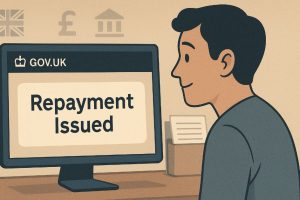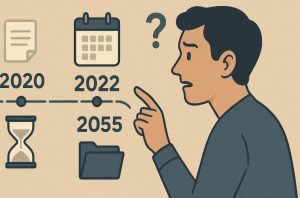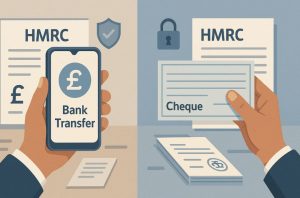For many taxpayers in the UK, receiving a notice that “repayment issued” from HMRC has appeared on their account is a moment of relief. However, it often leads to one pressing question: How long after repayment issued does HMRC actually send the money?
The answer isn’t as straightforward as it might seem. With processing times affected by the time of year, your method of filing, and even bank processing delays, knowing when you’ll receive your refund can be tricky. This detailed guide breaks down the entire repayment journey from submission to payout, explaining each stage and helping you understand what to expect in 2024.
What does “repayment issued” by HMRC actually mean?

The phrase “repayment issued” means that HMRC has completed all necessary checks and approved a refund. It signals that the repayment has been authorised internally and is on its way to you, either through a bank transfer or by cheque. However, this status doesn’t necessarily mean the money has left HMRC’s account just yet.
In most cases, there is a brief delay between the status update in your online account and the actual processing of the payment by HMRC’s financial systems. Think of it as a “payment in transit” phase the funds are scheduled for release, but they may not appear in your bank account on the same day.
How long does HMRC take to process a tax refund?
The length of time HMRC takes to issue a tax refund after marking it as “repayment issued” depends largely on how your return was filed and how the refund is being delivered.
Online filing is significantly faster
If your tax return was filed online and HMRC has your correct bank details, you can usually expect your refund within 5 to 10 working days from the date shown as “repayment issued”. For many, it happens even faster particularly for straightforward PAYE or self-assessment returns.
Paper submissions take longer
Paper returns require manual processing. They are subject to longer verification times, and often extend the repayment time to up to 6 weeks, especially during busy seasons like January and April.
What factors affect the HMRC repayment timeline?
Several variables can influence how quickly you receive your repayment after HMRC issues it. These aren’t always visible to the taxpayer but can significantly impact the waiting time.
Internal workload and tax year peak times
HMRC receives an enormous volume of tax returns during peak periods. Self-assessment returns due in January and the end-of-tax-year filings in April can overwhelm the system, leading to slower processing and delays in repayments.
Type of taxpayer
Sole traders, freelancers, and those with multiple income streams may face longer verification times compared to salaried employees with simple PAYE profiles. This is because more complex returns require more thorough checking.
Missing or incorrect information
Even minor issues such as an outdated address, a wrong account number, or a typo in your sort code can delay the release or delivery of your refund. If HMRC can’t match the provided details with official records, they’ll flag the repayment for review.
Can HMRC repayment times vary for different tax years?

Yes, they can. Refunds related to recent tax years are easier to process because the data is still active in HMRC’s system. But when you’re claiming for a tax year several years in the past, HMRC may need to manually access archived information.
If you’re reclaiming tax from four or more years ago, HMRC might ask for additional documents, such as P60s or payslips, to verify your entitlement. This process extends the timeline significantly and usually requires you to submit a written claim to support your request.
What should you do if your HMRC refund is delayed?
If your “repayment issued” status was updated over two weeks ago and you still haven’t received your money, it’s time to investigate. Delays can occur due to processing issues, bank rejections, or address mismatches.
You should first log in to your Personal Tax Account and double-check the repayment status. Confirm that your bank details are correct and that no alerts or messages from HMRC have been posted to your account.
If everything looks in order and more than 14 working days have passed, it’s advisable to contact HMRC directly by phone or through their secure messaging system. Be ready to provide your UTR (Unique Taxpayer Reference) and details about the claim.
How can you track your HMRC repayment status?
Your HMRC online account and mobile app are the main tools for monitoring the progress of your tax refund. Once your repayment has been processed, you’ll typically see a “repayment issued” message along with key details.
Here’s what you can track:
- The status of your repayment (e.g. “repayment issued”)
- The amount being refunded and the payment reference
- The bank account where the refund is being sent
- An estimated date of arrival (when available)
However, it’s important to note that HMRC does not offer detailed payment tracking similar to postal or banking apps. You won’t see real-time updates once the money leaves HMRC’s system.
How is the HMRC refund paid bank transfer or cheque?

HMRC prefers paying refunds directly into a bank account via BACS (Bankers’ Automated Clearing Services). This method is quicker, traceable, and less prone to errors.
When bank details are missing or incorrect, HMRC issues the refund by cheque, posted to the address on file. Cheques are slower, more susceptible to postal delays, and riskier in terms of fraud or loss.
| Payment Method | Time to Receive | Reliability |
| Bank Transfer | 3–10 working days | Very High |
| Cheque | 7–14 working days | Moderate |
What is the typical waiting time after self-assessment?
For most individuals filing self-assessment tax returns, the waiting period after the “repayment issued” notice is about 5 to 10 working days. This assumes that the return was filed online and that correct bank details were submitted.
Those who filed on paper or are expecting a cheque instead of a bank transfer may need to wait significantly longer often up to 6 weeks, particularly during peak periods.
Are there common reasons for repayment issues or rejections?
There are a number of reasons why your repayment might be delayed or even rejected by HMRC. Some of the most common include:
- Incorrect or missing bank details submitted with your tax return.
- Outstanding debts or tax penalties owed to HMRC which are deducted from your refund.
- Duplicate refund requests, triggering a security hold on your repayment.
In many cases, you’ll be contacted by letter or message in your online account, asking you to confirm your details or provide additional documentation.
When should you contact HMRC about a missing refund?

If it has been more than three weeks since your repayment was marked as issued, and you haven’t received the funds or a cheque in the post, you should contact HMRC. Before you do, check your tax account to ensure there are no notifications or alerts.
When calling HMRC, be sure to have your National Insurance number, UTR, and repayment details ready. You can reach them via phone at 0300 200 3300 or by using the online messaging service if you prefer not to wait in a call queue.
What can you expect if your bank delays the HMRC payment?
Although HMRC may issue your payment promptly, your bank’s internal processing could cause delays. Most UK banks process BACS payments within three working days, but some can take longer if manual checks are required.
One common cause of delay is incorrect account information. If HMRC sends money to the wrong or closed account, it may take additional time for the funds to be returned and reprocessed. In such cases, HMRC will likely notify you, but the reissue process can add several weeks to your waiting time.
How do repayment timelines compare in 2025 vs previous years?
Over the last few years, HMRC has made improvements to their digital systems, and many tax payers have reported faster refund times in 2025 compared to 2023 or 2024. Online repayments are now more reliable and quicker, especially when submitted early in the tax year. During 2020 and 2021, refunds were often delayed due to staffing shortages and system backlogs caused by the pandemic. Those issues have largely been resolved, meaning the average processing time has returned to pre-pandemic levels or even improved.
What are some tips to speed up your HMRC repayment?

If you want your repayment processed as quickly as possible:
- File your return online, ideally outside of peak season.
- Double-check that your bank details are correct and up to date.
By avoiding common errors and keeping your tax records organised, you improve your chances of receiving your refund without delay.
Conclusion
If you’re wondering how long after repayment issued HMRC actually delivers your refund, the average answer is 5 to 10 working days for most online submissions with correct bank details. However, delays can occur depending on the time of year, the filing method, and any problems with your information.
For paper returns or cheque payments, expect a waiting period of up to 6 weeks. While HMRC has improved its systems in 2024, staying proactive by checking your account regularly and submitting your return early in the year can help you avoid unnecessary stress.
FAQs About HMRC Repayment Timelines
How long does a cheque from HMRC take to arrive?
Cheques typically take 7 to 14 working days to arrive, depending on postal service and address accuracy.
Why is my HMRC repayment delayed even after being issued?
Delays may occur due to incorrect bank details, high processing volume, or pending identity checks by HMRC.
Can HMRC deduct money from my refund?
Yes, if you owe other tax debts or penalties, HMRC can deduct those amounts from your repayment before issuing it.
Does the HMRC app show repayment updates?
Yes, the HMRC app displays updates, including repayment issued status, amounts, and linked bank details.
Is it faster to get a refund if I use an accountant?
Possibly. Accountants can help you avoid common errors and ensure correct documentation, reducing the risk of delays.
What should I do if I accidentally filed the wrong bank details?
Contact HMRC immediately. If the repayment has already been issued, the funds may bounce back, and a reissue will be required.
Will future repayments be faster after the first one?
Often, yes. Once HMRC verifies your identity and account, future repayments tend to be quicker if no changes are made.









Leave feedback about this